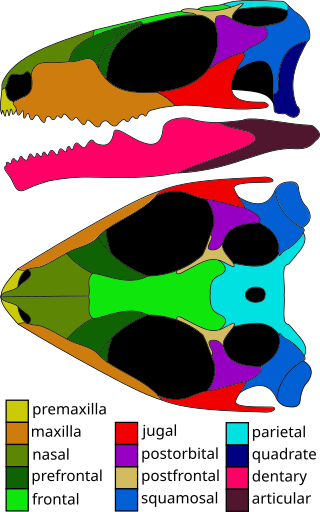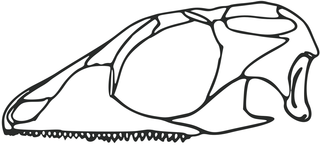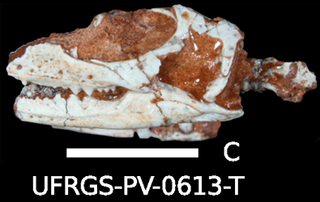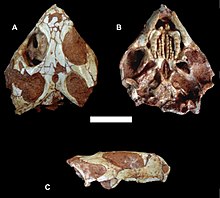
Rhynchocephalia is an order of lizard-like reptiles that includes only one living species, the tuatara of New Zealand. Despite its current lack of diversity, during the Mesozoic rhynchocephalians were a speciose group with high morphological and ecological diversity. The oldest record of the group is dated to the Middle Triassic around 238 to 240 million years ago, and they had achieved a worldwide distribution by the Early Jurassic. Most rhynchocephalians belong to the group Sphenodontia ('wedge-teeth'). Their closest living relatives are lizards and snakes in the order Squamata, with the two orders being grouped together in the superorder Lepidosauria.

Planocephalosaurus is an extinct genus of basal rhynchocephalian. Fossils of the genus are primarily known from fissure fill deposits from the Late Triassic of southwest Britain, with fragmentary remains possibly belonging to the genus also known from the Late Triassic of Texas.

Terrestrisuchus is an extinct genus of very small early crocodylomorph that was about 76 centimetres (30 in) long. Fossils have been found in Wales and Southern England and date from near the very end of the Late Triassic during the Rhaetian, and it is known by type and only known species T. gracilis. Terrestrisuchus was a long-legged, active predator that lived entirely on land, unlike modern crocodilians. It inhabited a chain of tropical, low-lying islands that made up southern Britain, along with similarly small-sized dinosaurs and abundant rhynchocephalians. Numerous fossils of Terrestrisuchus are known from fissures in limestone karst which made up the islands it lived on, which formed caverns and sinkholes that preserved the remains of Terrestrisuchus and other island-living reptiles.

Slickstones Quarry, Cromhall, also known as Cromhall Quarry, is a 2.7 hectare geological Site of Special Scientific Interest near the village of Cromhall, South Gloucestershire, England notified in 1966.

Pleurosauridae is an extinct family of sphenodontian reptiles, known from the Jurassic of Europe. Members of the family had long-snake like bodies with reduced limbs that were adapted for aquatic life in marine environments. It contains two genera, Palaeopleurosaurus, which is known from the Early Jurassic (Toarcian) Posidonia Shale of Germany, as well as Pleurosaurus from the Late Jurassic of Germany and France. Paleopleurosaurus is more primitive than the later Pleurosaurus, with a skull similar to those of other sphenodontians, while that of Pleurosaurus is highly modified relative to other sphendontians. They likely swam via anguilliform locomotion. Vadasaurus and Derasmosaurus from the Late Jurassic and Early Cretaceous of Europe have been placed as part of this family in some studies, but lack the body elongation that typifies the other two genera.

The Magnesian Conglomerate is a geological formation in Clifton, Bristol in England, Gloucestershire and southern Wales, present in Tytherington, Durdham Down, Slickstones Quarry and Cromhall Quarry.

Opisthias is a genus of sphenodont reptile. The type species, Opisthias rarus, is known from the Late Jurassic (Kimmeridgian-Tithonian) of western North America.

Diphydontosaurus is an extinct genus of small rhynchocephalian reptile from the Late Triassic of Europe. It is the most primitive known member of Sphenodontia.

Gephyrosaurus is a genus of early rhynchocephalian first described and named in 1980 by Susan E. Evans. They are distantly related to the extant Sphenodon with which they shared a number of skeletal features including a large tooth row along the side of the palatine bone and posterior process of the dentary bone. The type species, G. bridensis, lived during Early Jurassic in Wales, UK. Whiteside & Duffin (2017) described the second species, G. evansae, known from a partial maxilla recovered from Late Triassic (Rhaetian) fissure fills in Carboniferous Limestone in Somerset. Gephyrosaurus, other potential gephyrosaurids and Wirtembergia are the only rhynchocephalians to lie outside Sphenodontia in modern definitions of the group, and have been found to be more closely related to squamates in some phylogenetic analyses.

Sphenovipera jimmysjoyi is an extinct species of sphenodontian dated from the Middle Jurassic. If was discovered in the lower part of the La Boca Formation located in Tamaulipas, Mexico. Only the lower jaw of this organism has been discovered and studied. It is possibly the only species of rhynchocephalian yet discovered to show evidence of venom delivery.

Opisthodontia is a proposed clade of sphenodontian reptiles, uniting Opisthias from the Late Jurassic-earliest Cretaceous of Europe and North America with the Eilenodontinae, a group of herbivorous sphenodontians known from the Late Triassic to Late Cretaceous.

Clevosaurs are an extinct group of rhynchocephalian reptiles from the Triassic and Jurassic periods.

Sapheosaurs are an extinct group of rhynchocephalian reptiles from the Late Jurassic period. "Sapheosaurs" is an informal name for a group of rhynchocephalians closely related to the genus Sapheosaurus. It was first recognized as a group containing multiple genera by Hoffstetter in 1955. The group has sometimes been given a formal taxonomic name as the family Sapheosauridae, although in some analyses this group belongs to the family Sphenodontidae and thus cannot be assigned its own family. They were fairly advanced rhynchocephalians which may have had semiaquatic habits.
Aenigmaspina is an extinct genus of enigmatic pseudosuchian (=crurotarsan) archosaur from the Late Triassic of the United Kingdom. Its fossils are known from the Pant-y-ffynnon Quarry in South Wales, of which its type and only known species is named after, A. pantyffynnonensis. Aenigmaspina is characterised by the unusual spines on its vertebrae, which are broad and flat on top with a unique 'Y' shape. Although parts of its skeleton is relatively well known, the affinities of Aenigmaspina to other pseudosuchians are unclear, although it is possibly related to families Ornithosuchidae, Erpetosuchidae or Gracilisuchidae.
The Avon Fissure Fill, also known as the Bristol Fissure Fill or Tytherington Fissure Fill, is a fissure fill in Avon, England which dates variously from the Norian and Rhaetian stages of the Late Triassic, or possibly as late as the Hettangian stage of the Early Jurassic. The fissure fill at Avon was a sinkhole formed by the dissolution of Lower Carboniferous limestones.

Pant-y-Ffynnon Quarry is a stone quarry in the Vale of Glamorgan, Wales, around 3 kilometers east of Cowbridge. It contains fissure fill deposits dating to the Late Triassic (Rhaetian), hosted within karsts of Carboniferous aged limestone, primarily the Friars Point Limestone Formation. Remains of numerous small vertebrates, notably archosaurs, are known from the fissure fills in the quarry, similar to other Late Triassic-Early Jurassic fissure fill deposits known from Southwest England and southern Wales.

Microsphenodon is an extinct genus of sphenodontian from the Late Triassic of Brazil. The type species is Microsphenodon bonapartei. It is a small sphenodontian with a skull roughly 20 mm long, and represents a unique mosaic of characteristics shared by both early diverging sphenodontians and eusphenodontian characters. Specimens of this taxon were first identified by Bonaparte and Sues (2006) but were misidentified as juvenile Clevosaurus brasiliensis, characteristics such as differences in the configuration of the teeth on the palate, and the unique form of tooth implantation seen in C. brasiliensis, helped differentiate these two co-occurring sphenodontian taxa.
Fraserosphenodon is an extinct genus of sphenodontian from the Late Triassic of the United Kingdom. It contains a single species, Fraserosphenodon latidens.
Pelecymala is an extinct genus of sphenodontian reptile that lived in southwest England during the Triassic period. It has been recovered in recent studies as a primitive member of the group.

Cryptovaranoides is an extinct genus of reptile from the Late Triassic Magnesian Conglomerate of England. It contains a single species, Cryptovaranoides microlanius.


















